General information
The painting instructions for Japanese ships can be found here: LINK. This page contains only basic information about the models and ships, along with the painting scheme that should be applied (the instructions on the linked page show what the specific scheme looks like).
Since the takeover of power by Tokugawa Ieasu at the turn of the 16th and 17th centuries, Japan has remained isolated from the world for over 250 years. The interventions of the Western powers and Russia meant that the Japanese had to quickly undertake the work of modernizing their country and navy. This process accelerated after the end of the Boshin War, which overthrew the shogunate and restored the Emperor to power, represented by a new elite of “autocratic technocrats”. Already in 1868, the creation of the Imperial Navy, known as Dai-Nippon Teikoku Kaigun or Nippon Kaigun for short, began with the amalgamation of the fleets of individual feudal lords.
The Japanese industry was too weak to produce modern ironclads, so the Empire was forced to buy them from foreign manufacturers. England and France were quickly tied up on this issue, which became the main shipbuilders and where their crews were trained. Some of the ships were bought thanks to emerging opportunities, such as the former CSS Stonewall Confederate ironclad ship.
In Japan, which had limited financial resources, the concept of the so-called French young school (jeune ecole), assuming the construction of rather light ships. The experiences of the Sino-Japanese war and the Battle of the Yalu River made the Japanese reject French concepts and adopted British ones (with local alterations). Thanks to huge war contributions, they could commission the construction of a battleship fleet (built by the British), which brought Japan victory in the war with Russia in 1904-1905.
6th Era – predrednoughts
GMT-JAP-001 Japanese Navy Squadron
This is the perfect set for the beginning of the adventure with the Japanese fleet. It includes the following:
Ship models:
– Shikishima class battleship,
– Kasuga/Nisshin class armoured cruiser,
– Naniwa class protected cruiser,
– Niitaka class protected cruiser,
– 4 Harusame class destroyers (2 for each base)
Dial sets x6
Ship’s cards x8 (Kasuga and Naniwa have two options)
Card sleeves x8
HDF bases for ships x6

GMT-JAP-002 Mikasa battleship
Class: 1.
Base length: 14 cm.
Color scheme: Standard Japanese war scheme.
Models in a set: 1.
Models on one base: 1.
Cards in a set: 1
Mikasa is a pre-dreadnought battleship built for the Imperial Japanese Navy (IJN) in the late 1890s. Named after Mount Mikasa in Nara, Japan, the ship served as the flagship of Vice Admiral Tōgō Heihachirō throughout the Russo-Japanese War of 1904–1905, including the Battle of Port Arthur and the Battles of the Yellow Sea and Tsushima.
Powerfully armed and well-armored, this is one of the most powerful battleships in the game, perfect for a flagship. While commanding Mikasa, you won’t be afraid to face any other enemy battleship. For who can defeat the ship of the legend?


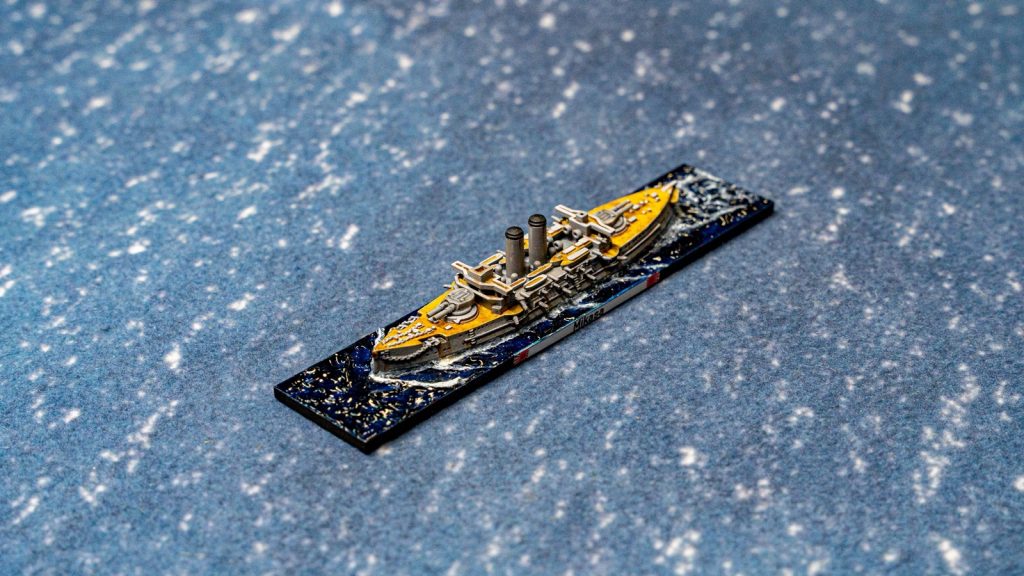
GMT-JAP-003 Shikishima class battleship
Class: 1.
Base length: 14 cm.
Color scheme: Standard Japanese war scheme.
Models in a set: 1.
Models on one base: 1.
Cards in a set: 1
The Shikishima class was a two-ship class of pre-dreadnought battleships built for the Imperial Japanese Navy in the late 1890s. As Japan lacked the industrial capacity to build such warships herself, they were designed and built in the UK. The ships participated in the Russo-Japanese War of 1904–1905, including the Battle of Port Arthur on the second day of the war.
The Shikishima was designed to interact with the rest of the Japanese battleships, having similar weapons and being able to develop similar speed. She’s a very balanced ship, with good armor and strong armament.




GMT-JAP-004 Kasuga class armored cruiser
Class: 2.
Base length: 12 cm.
Color scheme: Standard Japanese war scheme.
Models in a set: 1.
Models on one base: 1.
Cards in a set: 2.
Kasuga was the name ship of the Kasuga-class armored cruisers of the Imperial Japanese Navy (as well as Nisshin), built in the first decade of the 20th century by Gio. Ansaldo & C., Sestri Ponente, Italy, where the type was known as the Giuseppe Garibaldi class.
Kasuga and Nisshin were well-designed armored cruisers with solid armor, good speed and armament. They could successfully cooperate with battleships, sailing in the back of the formation. They will be the terror of any other enemy cruiser.
This model can be configured in two ways, as these twin ships were armed differently. The Kasuga had a turret with a single 254mm cannon at the front and a turret with two 203mm cannons at the rear, while the Nisshin had both turrets equipped with 203mm cannons. Therefore, two cards are added to the set so that you can – by changing only the towers – play with one or the other ship.
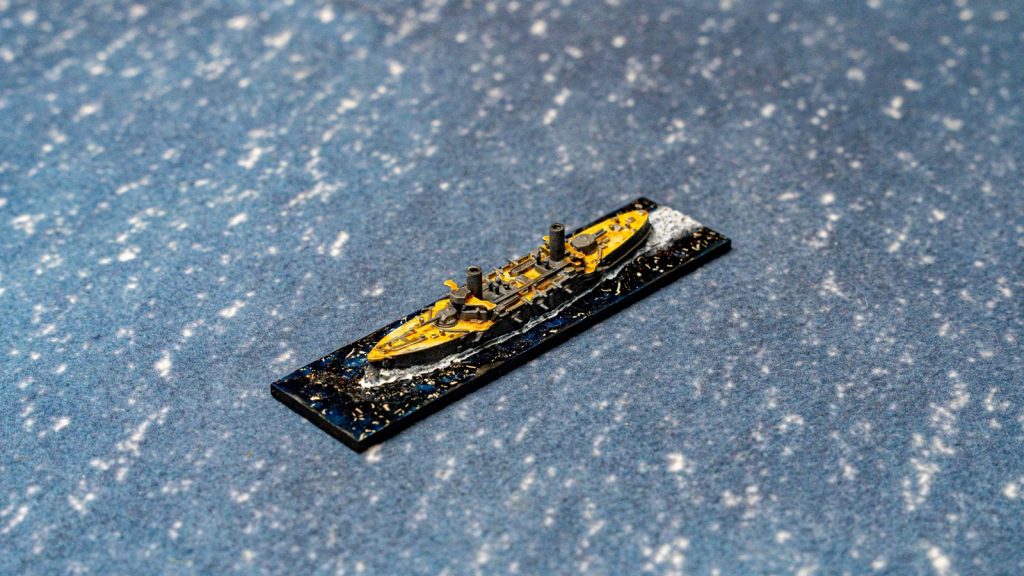


GMT-JAP-005 Niitaka class protected cruiser
Class: 3.
Base length: 12 cm.
Color scheme: Standard Japanese war scheme.
Models in a set: 1.
Models on one base: 1.
Cards in a set: 1.
The two Niitaka-class cruisers were protected cruisers operated by the Imperial Japanese Navy. These small cruisers were intended for high speed reconnaissance.
They can outclass many other contemporary protected cruisers.
Niitaka is a great medium-sized ship. Well-armed, fast, with decent armor, she will cause a lot of problems for equally large and smaller enemy ships.

GMT-JAP-006 Naniwa class armored cruiser
Class: 3.
Base length: 10 cm.
Color scheme: Standard Japanese war scheme.
Models in a set: 1.
Models on one base: 1.
Cards in a set: 2.
The two Naniwa-class cruisers were protected cruisers built for the Imperial Japanese Navy (IJN) during the 1880s. As Japan lacked the industrial capacity to build such warships herself, the vessels were built in Britain.
Naniwa is a reminder of the philosophy of building cruisers from the 1880s. Fast, poorly armored, but armed with powerful guns, the ship will be a threat to anyone, even a huge enemy, but is also very vulnerable. At the beginning of the 20th century, ships of this type were modernized and the heavy guns were replaced with medium ones.
This model can be configured in two ways – with the old 260mm cannons or the new 152mm. Therefore, two cards are included in the set (one named as Naniwa, the other as Takachiho), allowing players to use pre-upgrade and post-upgrade ships.
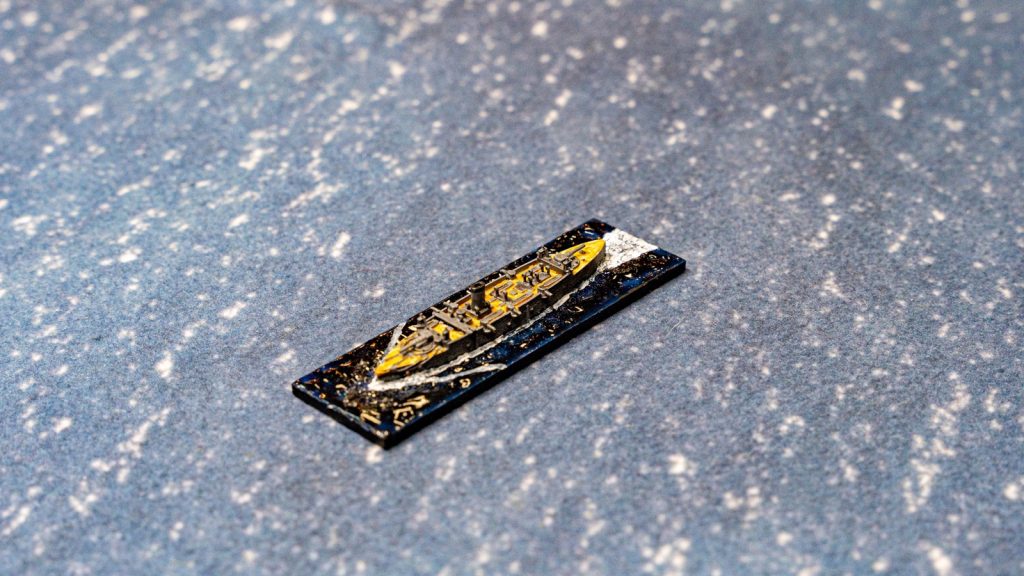
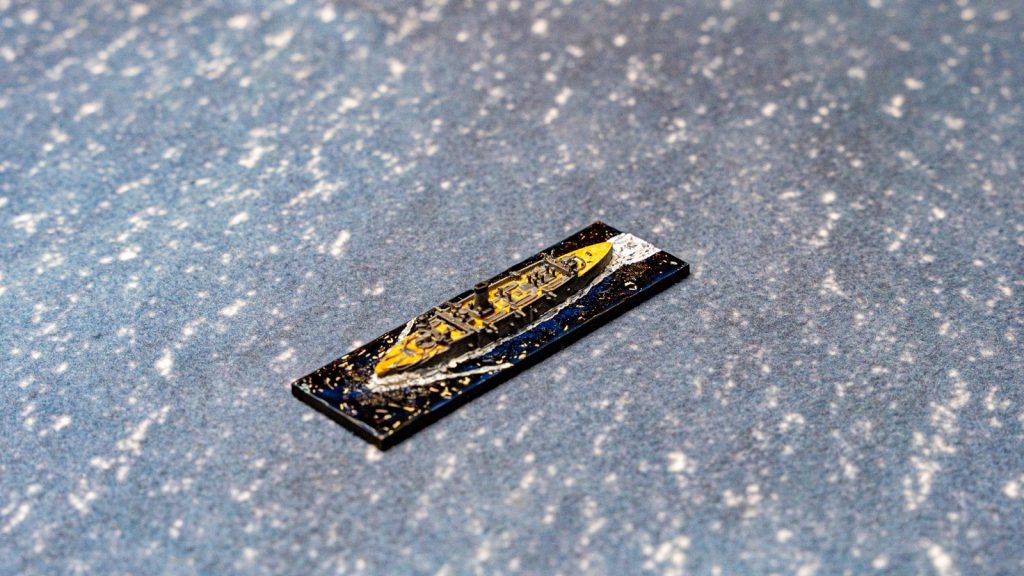


GMT-JAP-007 Harusame class destroyer
Class: 4.
Base length: 8 cm.
Color scheme: Standard Japanese war scheme.
Models in a set: 4.
Models on one base: 2.
Cards in a set: 2.
The Harusame-class destroyers was a class of seven torpedo boat destroyers (TBDs) of the Imperial Japanese Navy. The Harusame class of destroyers were the first destroyers to be built in Japan.
Harusame is one of the best destroyers in the game. Fast, armed with powerful torpedoes, she will be the terror of large enemy ships.

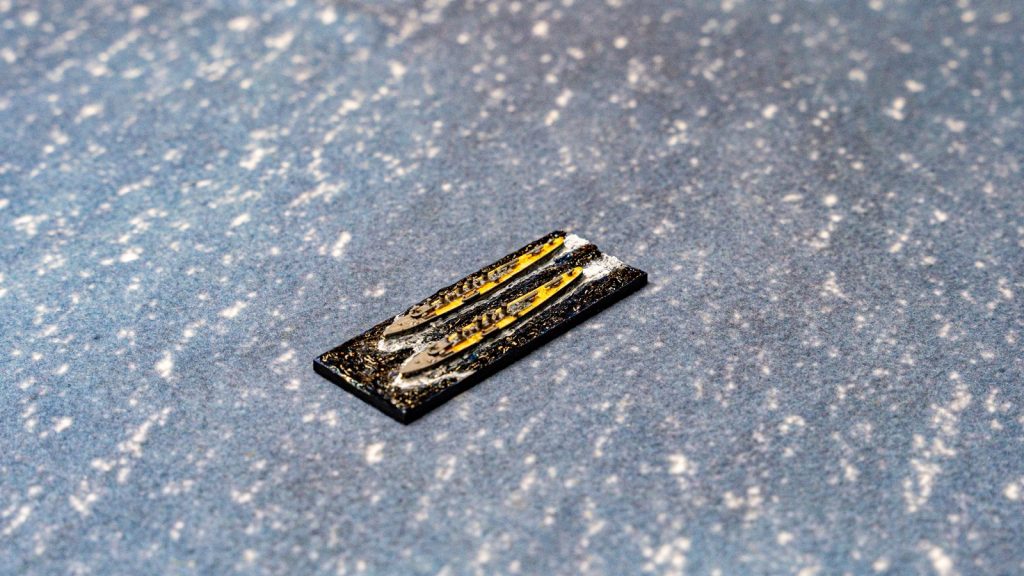
GMT-JAP-008 Hayabusa class torpedo boat
Class: 4.
Base length: 6 cm.
Color scheme: Standard Japanese war scheme.
Models in a set: 4.
Models on one base: 2.
Cards in a set: 2.
The Hayabusa-class torpedo boats were a class of fifteen 1st class torpedo boats constructed for the Imperial Japanese Navy as part of the 1896 Ten Year Naval Expansion Programme. They were completed between 1900 and 1904.
Small, fast, cheap, well armed with torpedoes – the Hayabusa is an excellent choice for those who like to command small ships.


GMT-JAP-009 Izumo class armored cruiser
Class: 2.
Base length: 14 cm.
Color scheme: Standard Japanese war scheme.
Models in a set: 1.
Models on one base: 1.
Cards in a set: 1.
The Izumo-class cruisers were a pair of armored cruisers built for the Imperial Japanese Navy in the late 1890s. The sister ships were part of the “Six-Six Fleet” expansion program that began after the defeat of China during the First Sino-Japanese War of 1894–1895.
The main task of cruisers of this type was reconnaissance and cooperation with battleships, hence they were – for this class of ships – very well armored and armed.
They will be the terror of any other enemy cruiser.




GMT-JAP-010 Katsuragi class corvette
Class: 4.
Base length: 8 cm.
Colour scheme: Standard Japanese war scheme.
Models in a set: 2.
Models on one base: 1.
Cards in a set: 2.
The Katsuragi class was a three-ship class of composite hulled, sail-and-steam corvettes of the early Imperial Japanese Navy.
Two of the three ships of this type bore names that are very familiar to naval military enthusiasts. It’s Yamato and Musashi. It is therefore worth remembering that before these names were given to Japanese super battleships, they were worn by small corvettes.
These well-armed – for their times – ships will be a good reinforcement of the Japanese fleet against light enemy ships.
The set includes two models. One version with raised sails, the other with extended ones. Because the model with unfurled sails looks beautiful, the player will be able to paint two versions of this model.






GMT-JAP-011 Azuma armoured cruiser
Class: 2.
Base length: 14 cm.
Colour scheme: Standard Japanese war scheme.
Models in a set: 1.
Models on one base: 1.
Cards in a set: 1.
Azuma (sometimes transliterated archaically as Adzuma) was an armoured cruiser built for the Imperial Japanese Navy (IJN) in the late 1890s. Budgetary problems resulted in Japan deciding to expand the number of ordered armoured cruisers from 4 to 6, instead of ordering more expensive battleships. The revised plan is commonly known as the “Six-Six Fleet”.
As Japan lacked the industrial capacity to build such warships herself, the ship was built in France, by Ateliers et Chantiers de la Loire. The ship was laid down on 1 February 1898, launched on 24 June 1898 and completed on 29 July 1900.
She participated in most of the naval battles of the Russo-Japanese War of 1904–05 and played a significant role in the sinking of the Russian armoured cruiser Rurik during the Battle of Ulsan. She was damaged in the mentioned battle, as well as in the Battle of Tsushima. The main task of cruisers of this type was reconnaissance and cooperation with battleships, hence they were – for this class of ships – very well armoured and armed.
They will be the terror of any other enemy cruiser.



GMT-JAP-012 Asahi battleship
Class: 1.
Base length: 14 cm.
Colour scheme: Standard Japanese war scheme.
Models in a set: 1.
Models on one base: 1.
Cards in a set: 1.
Asahi, meaning “rising sun”, was a pre-dreadnought battleship built for the Imperial Japanese Navy, laid down on 1 August 1898, launched on 13 March 1899 and completed on 31 July 1900.
As with the earlier Fuji and Shikishima classes, Japan lacked the technology and capability to construct its own battleships, and turned again to the United Kingdom. Asahi, the fifth Japanese battleship to be built in Britain, was ordered from the Clydebank Engineering & Shipbuilding Company shipyard in Clydebank, Scotland in the 1897 annual naval programme.
She participated in every major naval battle of the Russo-Japanese War of 1904–1905 and was lightly damaged during the Battle of the Yellow Sea and the Battle of Tsushima.
Well-armoured and armed, Asahi will be a formidable opponent for any other battleship in the opposing fleet.



GMT-JAP-013 Chiyoda protected cruiser
Class: 3.
Base length: 10 cm.
Colour scheme: Standard Japanese war scheme.
Models in a set: 1.
Models on one base: 1.
Cards in a set: 1.
Chiyoda was a cruiser of the Imperial Japanese Navy, ordered as a replacement for the ill-fated Unebi, after that ship disappeared without a trace somewhere in the South China Sea en route to Japan. This time Japan placed its order in 1889 to J & G Thomson of Glasgow, Scotland.
Chiyoda was a ‘belted cruiser’ based on a much scaled-down version of the Royal Navy’s Nelson-class cruisers.
Chiyoda was present at all of the significant battles of the First Sino-Japanese War, including the crucial Battle of Yalu River and the Battle of Weihaiwei. During the Russo-Japanese War (1904–1905), Chiyoda had a prominent role in the opening Battle of Chemulpo Bay and subsequently fought at the Battle of the Yellow Sea and the Battle of Ulsan.
Given its size, Chiyoda is quite well-armed and armoured, making it capable not only of engaging with most third-class cruisers but also posing a threat to significantly smaller vessels.



GMT-JAP-014 39-Go class torpedo boat
Class: 4.
Base length: 6 cm.
Colour scheme: Standard Japanese war scheme.
Models in a set: 4.
Models on one base: 2.
Cards in a set: 2.Following the victory in the First Sino-Japanese War (1894-1895), Japan received substantial war reparations, enabling an intensive fleet expansion program. As part of this initiative, the augmentation of torpedo boats, including smaller second-class ones, designed for operations near Japanese shores, was initiated. The construction of the 39-go torpedo boat series began in 1899 at the British Yarrow shipyard, adhering to Japanese specifications.
All vessels of this type participated in the Russo-Japanese War of 1904-1905, achieving modest success.
The 39-go torpedo boat will be an intriguing alternative for players commanding the Japanese navy. Slower and less heavily armed than Japanese destroyers or later torpedo boats, they will, however, be competitively priced, making them a viable choice for players looking to have multiple vessels in their fleet.



